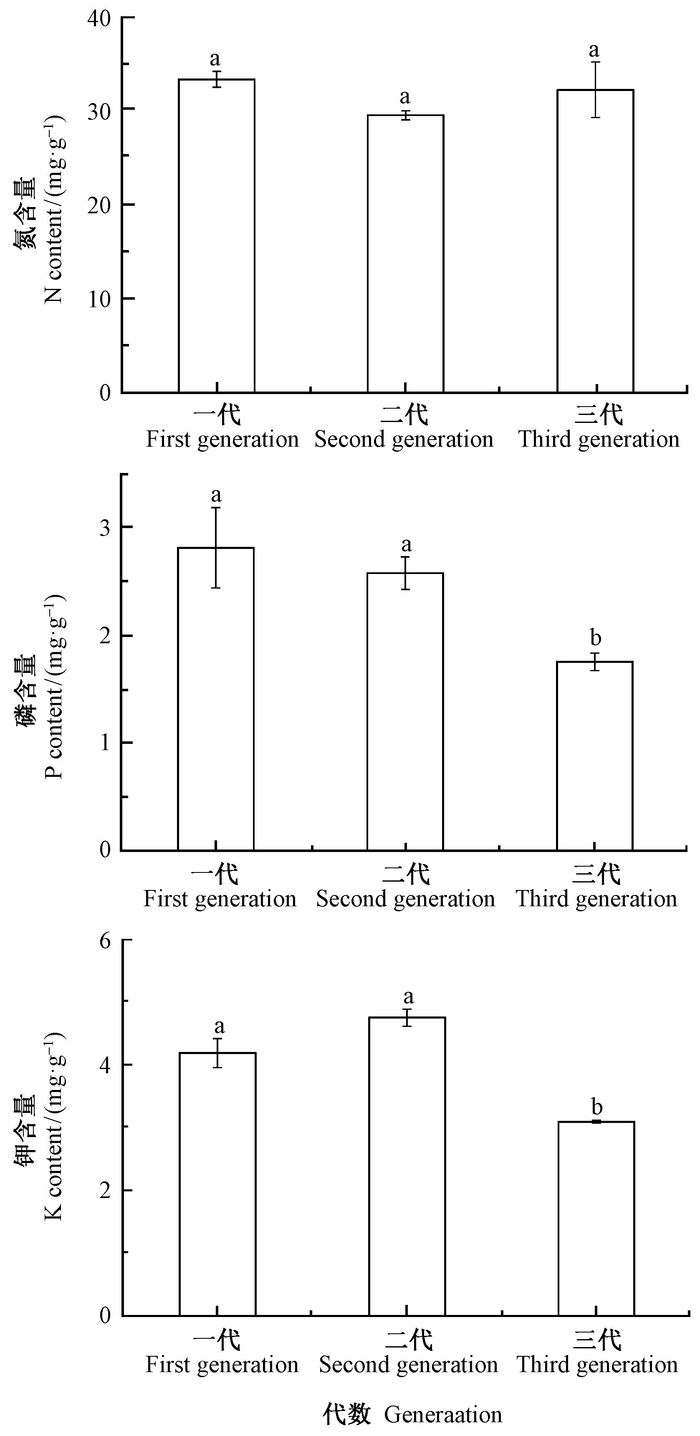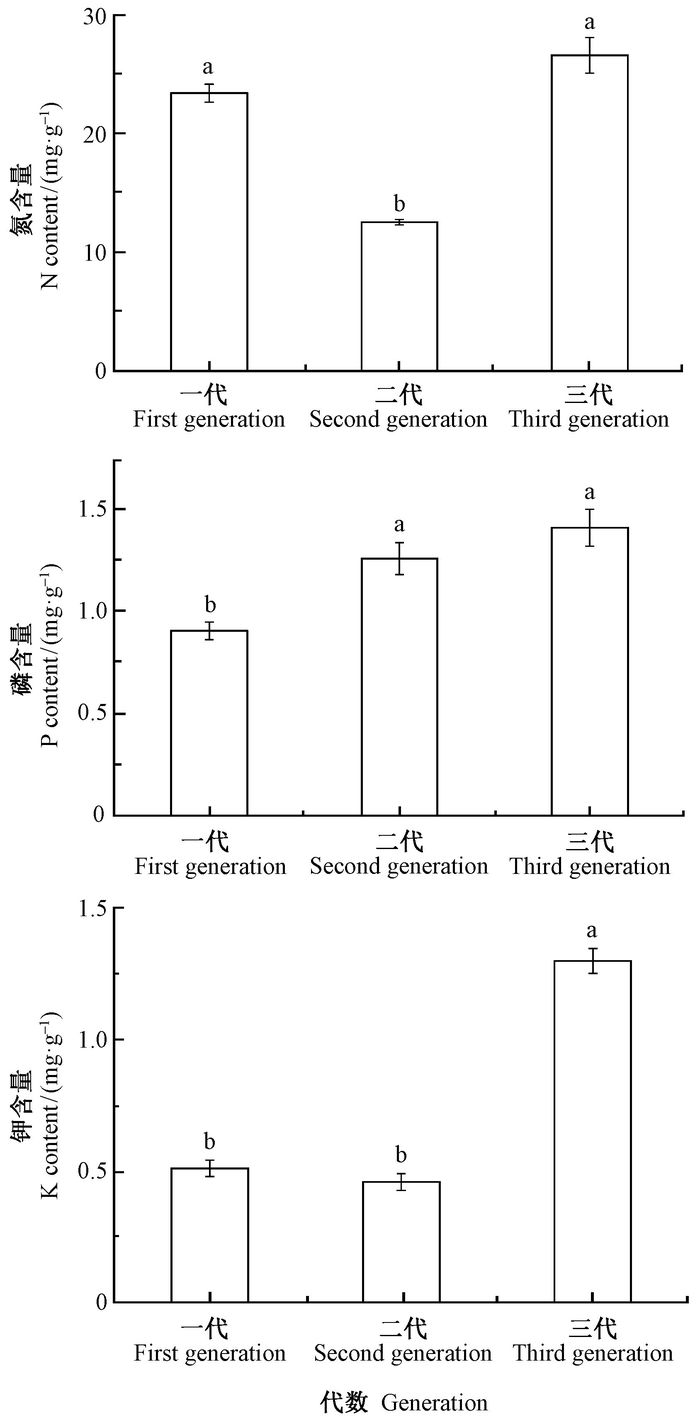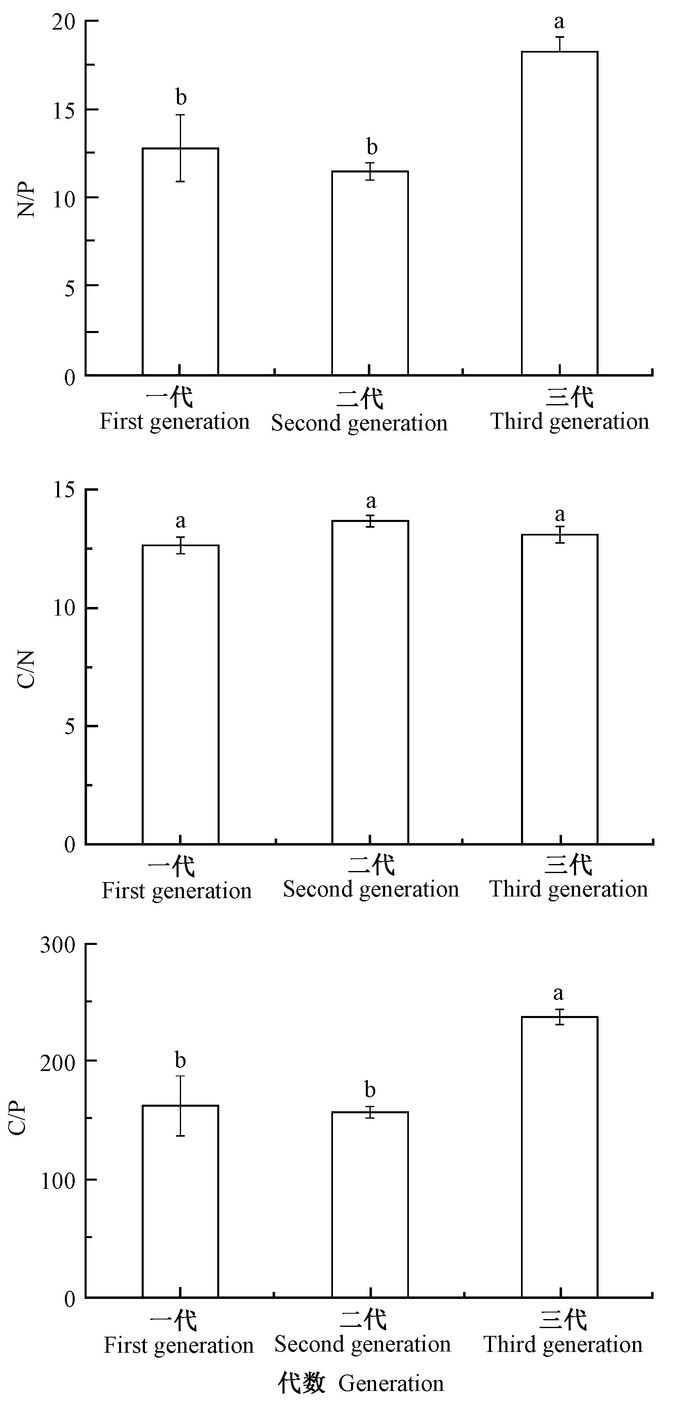文章信息
- 李坤, 李传荣, 杨焕祥, 梁强, 刘莉莉, 张彩虹
- Li Kun, Li Chuanrong, Yang Huanxiang, Liang Qiang, Liu Lili, Zhang Caihong
- 连作对欧美杨Ⅰ-107叶片主要养分元素化学计量特征的影响
- The Effects of Continuous Cropping on Major Nutrient Elements and C/N/P Stoichiometric Ratios of Leaf of Populus×euramericana 'Neva'
- 林业科学, 2017, 53(5): 164-169.
- Scientia Silvae Sinicae, 2017, 53(5): 164-169.
- DOI: 10.11707/j.1001-7488.20170519
-
文章历史
- 收稿日期:2015-08-12
- 修回日期:2017-04-21
-
作者相关文章
2. 山东农业大学农业生态与环境重点实验室 泰安 271018
2. Key Laboratory of Agricultural Ecology and Environment, Shandong Agricultural University Tai'an 271018
欧美杨Ⅰ-107(Populus×euramericana ‘Neva’)作为一种多用途速生丰产林树种,在我国种植面积大,分布范围广。近年来,发现欧美杨Ⅰ-107人工林连作会导致林地生产力下降及地力衰退(王延平等,2013)。目前关于连作人工林生产力下降的研究较多,主要集中在土壤理化性质(刘福德等,2005;王延平等,2013)、生产力(孙翠玲等,1995)变化等方面,而关于连作欧美杨Ⅰ-107叶片C,N,P,K等化学计量特征的研究还十分匮乏,从而难以全面揭示连作对欧美杨Ⅰ-107人工林养分循环的影响。因此,本研究探讨连作情况下欧美杨Ⅰ-107叶片N,P,K回收率和C/N、C/P、N/P的化学计量特征,阐明连作对欧美杨Ⅰ-107人工林养分循环的影响,以期为合理经营连作欧美杨Ⅰ-107人工林提供理论依据。
1 研究区概况研究区位于山东省泰安市宁阳县国有高桥林场(116°48′—116°55′E, 35°41′—35°45′N),位于大汶河沿岸河滩地,土壤为粗沙质河潮土,颗粒较粗,保肥保水性差,有机质含量较低,地下水位5~8 m,属于温带大陆性半湿润季风气候区,年均降水量697 mm,≥10 ℃年积温4 731 ℃,≤10 ℃年积温4 213 ℃。研究对象为抚育和管理措施相同的欧美杨Ⅰ-107一代(Ⅰ)、二代(Ⅱ)和三代(Ⅲ)纯林。3种林分均在2009年春季营造,林龄4年,株行距均为3 m×5 m,密度667株·hm-2。南北行距,林分生长较均匀,土壤肥力低(有机质含量0.14%,碱解氮含量4 mg·kg-1,速效磷含量2.1 mg·kg-1)。营造后的第1,2年均曾间作落花生(Arachis hypogaea),但当前林地无作物间作,无浇水和施肥等管理措施。林分生长状况见表 1(许坛等,2014)。
2 研究方法 2.1 样品采集分别在高桥国有林场的一代、二代(连作1代)和三代(连作2代)欧美杨Ⅰ-107人工林设置3块20 m×20 m样地。2013年8月中旬和11月底在每块样地内随机选择3株平均木采集叶片,分别采集成熟叶和凋落叶(选择叶片刚凋落时收集),每株平均木成熟叶和凋落叶各50 g。为了减少叶片所处位置对养分含量的影响,分别采集每株欧美杨Ⅰ-107阴面叶片和阳面叶片各3份进行混合,且叶片均取自树冠下层。所有采集的样品实验室65 ℃烘干24 h,信封内保存备用。
2.2 样品养分含量的测定为了研究欧美杨Ⅰ-107叶片N,P,K的养分回收效率和叶片C/N、C/P、N/P特征,测定了叶片C,N,P,K含量。养分含量测定前,采用植物粉碎机(FZ-102) 粉碎。参考森林生态系统长期定位观测方法,叶片全碳(碳元素)、全氮(氮元素)含量采用元素分析仪(Costech公司的ECS4010,意大利)测定;叶片全磷(磷元素)含量采用酸溶-钼锑抗比色法测定;叶片全钾(钾元素)含量采用火焰光度计(FP640) 测定。
2.3 数据处理养分回收率(NRE)计算公式为:

|
式中:W1为成熟叶养分含量;W2为凋落叶养分含量,单位为mg·g-1(闫涛等,2014)。采用SPSS 17.0软件进行数据分析,不同连作代数间的NRE平均数采用单因素方差分析(one-way ANOVA),用Duncan进行差异显著性比较。
3 结果与分析 3.1 连作欧美杨Ⅰ-107成熟叶和凋落叶中N,P,K含量从图 1和图 2可见,随着连作代数增加,欧美杨Ⅰ-107叶片中N,P,K含量均发生了一定变化。对于成熟叶而言(图 1),一代林和二代林叶片中N,P,K含量差异不显著。成熟叶片中全N含量最高的是二代林,其次是一代林和三代林,三者之间差异不显著(P>0.05),这说明连作对欧美杨Ⅰ-107成熟叶中N含量影响不大。成熟叶中P含量随着代数增加而降低,且一代林和二代林成熟叶片P含量显著高于三代林(P<0.05)。与P含量变化不同,一代林和二代林成熟叶的K含量显著高于三代林(P<0.05),但是二代林成熟叶的K含量与一代林差异不显著(P>0.05)。在欧美杨Ⅰ-107凋落叶中(图 2),一代林和三代林凋落叶中的全N含量显著高于二代林(P<0.05);但是二代林凋落叶P含量显著高于一代林(P<0.05),与三代林差异不显著(P>0.05);三代林凋落叶K含量显著高于一代林和二代林(P<0.05)。

|
图 1 欧美杨Ⅰ-107成熟叶N,P,K含量 Fig.1 N, P, and K contents in mature leaves of Populus×euramericana 'Neva' 不同代数间不同小写字母表示差异显著(α=0.05)。 Different little letters among different generations mean significant difference at 0.05 level. |

|
图 2 欧美杨Ⅰ-107凋落叶N,P,K含量 Fig.2 N, P, and K contents in leaf litters of Populus×euramericana 'Neva' 不同代数间不同小写字母表示差异显著(α=0.05)。 Different little letters among different generations mean significant difference at 0.05 level. |
欧美杨Ⅰ-107凋落叶N,P,K含量都显著低于成熟叶(P<0.05),说明欧美杨Ⅰ-107叶片存在养分回收现象。由图 3可见,连作对N, P, K 3种营养元素的养分回收率有显著的影响。不同代数N回收率之间差异显著(P<0.05),二代林的N回收率显著高于一代林和三代林(P<0.05)。不同代数之间P回收率差异显著(P<0.05),且随着代数增加,P的回收率逐渐降低,最低仅为19.24%。一代林和二代林K回收率无显著差异(P>0.05),但是都显著高于三代林(P<0.05)。整体而言,除二代林外,N的回收率低于P和K的回收率。

|
图 3 欧美杨Ⅰ-107叶片养分回收率 Fig.3 Nutrient recovery efficiency of Populus×euramericana 'Neva' leaves 不同小写字母分别表示不同代数同一元素的回收率差异性显著(P<0.05);不同大写字母分别表示同一代数不同元素的回收率的差异显著(P<0.05)。 Different lowercase letters show the difference of the resorption efficiency of different generation in the same elements (P < 0.05).Different capital letters show the difference of the resorption efficiency of the same generation in different elements respectively(P < 0.05). |
对于成熟叶片(图 4)三代林的C/P和N/P都显著高于一代林和二代林(P<0.05),而一代林和二代林之间差异不显著(P>0.05)。不同代数之间成熟叶C/N差异不显著(P>0.05)。连作降低了凋落叶中N/P和C/P,并且二代林和三代林中凋落叶内N/P和C/P显著低于一代林(P<0.05),同时增加了二代林凋落叶中的C/N(图 5),这些变化将影响凋落叶的分解过程。

|
图 4 欧美杨Ⅰ-107成熟叶片N/P,C/N,C/P特征 Fig.4 N/P, C/N, and C/P features in mature leaves of Populus×euramericana 'Neva' |

|
图 5 欧美杨Ⅰ-107凋落叶片N/P,C/N,C/P特征 Fig.5 N/P, C/N, and C/P features in leaf litters of Populus×euramericana 'Neva' |
本研究中,成熟叶的N, P, K含量随着连作代数增加而降低,主要原因是连作导致土壤肥力(刘福德等,2005;王延平等,2013;许坛等,2014)和植物光合效能下降(艾钊,2015),引起植物生长受阻,叶片养分含量下降。连作增加凋落叶中N,P,K含量,主要是植物对N,P和K的回收率下降导致的(邓浩俊等,2015),尤其是三代林。本研究中,欧美杨Ⅰ-107在连作条件下,凋落叶中的养分浓度低于成熟叶,这部分养分回收后重新参与植物体内循环,避免其过多依赖土壤环境条件。
二代林N的回收率显著高于一代林和三代林(P<0.05)。主要是因为二代林中草本植物较多,生长旺盛,在一定程度上降低了土壤中的N含量(焦峰等,2005),促使二代林通过增加养分回收率来维持其本身的正常生长发育。随着连作代数增加,欧美杨Ⅰ-107对P,K的回收率下降,可能是因为K易于流失导致的(理永霞等,2009),而K作为细胞中调节渗透压的关键因子,在养分回收过程中细胞需要一直调节细胞渗透压直到其他养分元素完成回收(Ruuhola et al., 2011)。本研究中三代林的K回收率显著低于其他林分(P<0.05),说明连作代数的增加将影响K的回收速度。
通常认为,凋落叶中N和P含量分别小于0.70%和0.05%时,N和P能被大部分回收,分别大于1.00%和0.08%时能被不完全回收(Killingbeck, 1996; 任丽昀等,2005)。在本研究中凋落叶中N和P浓度分别大于1.00%和0.08%,且随着连作代数的增加,凋落叶中的N,P含量增加。因此,本试验中N和P均被不完全吸收,表明欧美杨Ⅰ-107养分转移较差。一代林内凋落叶中P含量为0.09%,相对而言,欧美杨Ⅰ-107对P的吸收较完全,说明连作条件下,P对欧美杨Ⅰ-107的限制更加明显。
4.2 连作对欧美杨Ⅰ-107叶片C/N、C/P和N/P比值的影响成熟叶片中N/P在一定程度上反映了植物受N或P的相对限制情况(银晓瑞等,2010),N/P小于14,表示受N限制,高于16,则受P限制(Koerselman et al., 1996)。本研究中,一代林和二代林内成熟叶片N/P均小于14,表明该林分受到N的限制,而三代林内成熟叶片N/P大于16,则受到P的限制。这可能也是导致一代和二代林内N回收率较高的原因。但是三代林中并未出现高的P回收率,反而较低,这也恰恰说明了连作欧美杨Ⅰ-107人工林内P循环受阻,不能很好地通过内循环保存P元素。欧美杨Ⅰ-107叶片中N/P的变化规律与P含量的变化规律相反,这说明试验地内叶片N/P主要受P含量控制,这与张文彦等(2010)的研究结果一致。本研究结果显示,凋落叶N/P高于成熟叶,这与李荣华等(2008)对马尾松的研究结果相似,与李征等(2012)的研究结果相反,可能是由于凋落叶中RNA含量较低导致的(Makino et al., 2003)。在凋落叶中,二代林和三代林叶片N/P显著低于一代林(图 3)。叶片凋落物中N/P是衡量其分解速率的良好指标,且与分解速率呈显著正相关(Güsewell, 2004)。可见,欧美杨Ⅰ-107连作可以通过降低叶片凋落物的N/P,从而降低其分解速率和N归还土壤的效率,这将影响土壤N库的补充,进而导致土壤养分可利用性减少,影响欧美杨Ⅰ-107通过根系吸收的养分量。
本研究中欧美杨Ⅰ-107叶片C/N和C/P的变化规律与其叶片中N,P含量的变化规律相反,说明欧美杨Ⅰ-107叶片中N,P含量对叶片C/N和C/P起主导作用,这与牛得草等(2013)、杨阔等(2010)和李征等(2012)的研究结果一致,主要是由于叶片中C含量均较高,且变化幅度较小。
5 结论综上所述,连作影响欧美杨Ⅰ-107成熟叶片和凋落叶片中N,P,K含量,特别是三代林显著降低N,P,K三大元素的回收率,影响养分内循环,进而降低植物对养分的利用率和保存能力;此外,连作通过改变凋落叶中化学计量比(降低凋落叶内N/P,增加凋落叶内C/N),间接地降低了凋落物分解速率,使养分归还到土壤中的节奏减缓,影响人工林生态系统养分归还,进而影响欧美杨Ⅰ-107人工林的丰产。
| [] |
艾钊. 2015. Ⅰ-107杨树不同连作代数人工林冠层光合作用特征. 泰安: 山东农业大学硕士学位论文. ( Ai Z. 2015. Effect of continuous cropping of poplar plantation community on photosynthesis. Tai'an:MS thesis of Shandong Agricultural University. [in Chinese]) |
| [] |
邓浩俊, 陈爱民, 严思维, 等. 2015. 不同林龄新银合欢回收率及其C:N:P化学计量特征. 应用与环境生物学报, 21(3): 522–527.
(Deng H J, Chen A M, Yan S W, et al. 2015. Nutrient resorption efficiency and C:N:P stoichiometry in different ages of Leucaena leucocephala. Chinese Journal of Applied Environmental Biology, 21(3): 522–527. [in Chinese]) |
| [] |
焦峰, 温仲明, 焦菊英, 等. 2005. 黄土丘陵区退耕地土壤养分变异特征. 植物营养与肥料学报, 11(6): 724–730.
(Jiao F, Wen Z M, Jiao J Y, et al. 2005. Heterogeneity of soil nutrients of cropland returning to forest on the loess hilly region. Plant Nutrition and Fertilizer Science, 11(6): 724–730. DOI:10.11674/zwyf.2005.0603[in Chinese]) |
| [] |
李荣华, 汪思龙, 王清奎. 2008. 不同林龄马尾松针叶凋落前后养分含量及回收特征. 应用生态学报, 19(7): 1443–1447.
(Li R H, Wang S L, Wang Q K. 2008. Nutrient contents and resorption characteristics in needles of different age Pinus massoniana (Lamb. ) before and after withering. Chinese Journal of Applied Ecology, 19(7): 1443–1447. [in Chinese]) |
| [] |
理永霞, 茶正早, 罗微, 等. 2009. 3种桉树幼苗叶片养分变化及其转移特性. 林业科学, 45(1): 152–157.
(Li Y X, Cha Z Z, Luo W, et al. 2009. Dynamics and transfer of nutrients in the seedling leaves of three Eucalyptus varieties. Scientia Silvae Sinicae, 45(1): 152–157. DOI:10.11707/j.1001-7488.20090126[in Chinese]) |
| [] |
李征, 韩琳, 刘玉虹, 等. 2012. 滨海盐地碱蓬不同生长阶段叶片C, N, P化学计量特征. 植物生态学报, 36(10): 1054–1061.
(Li Z, Han L, Liu Y H, et al. 2012. C, N and P stoichiometric characteristics in leaves of Suaeda salsa during different growth phase in coastal wetlands of China. Chinese Journal of Plant Ecology, 36(10): 1054–1061. [in Chinese]) |
| [] |
刘福德, 姜岳忠, 王华田, 等. 2005. 杨树人工林连作效应的研究. 水土保持学报, 19(2): 102–105.
(Liu F D, Jiang Y Z, Wang H T, et al. 2005. Effect of continuous cropping on poplar plantation. Journal of Soil and Water Conservation, 19(2): 102–105. [in Chinese]) |
| [] |
牛得草, 李茜, 江世高, 等. 2013. 阿拉善荒漠区6种主要灌木植物叶片C:N:P化学计量比的季节变化. 植物生态学报, 37(4): 317–325.
(Niu D C, Li Q, Jiang S G, et al. 2013. Seasonal variations of leaf C:N:P stoichiometry of six shrubs in desert of China's Alxa Plateau. Chinese Journal of Plant Ecology, 37(4): 317–325. [in Chinese]) |
| [] |
任丽昀, 袁志友, 王洪义, 等. 2005. 中国北部半干旱区乔木、灌木和草本3种不同生活型植物的氮素回收特征. 西北植物学报, 25(3): 497–502.
(Ren L Y, Yuan Z Y, Wang H Y, et al. 2005. Nitrogen resorption of three life-forms (trees, shrubs and grasses) in the semi-arid region of North China. Acta Botanica Boreali-Occidentalia Sinica, 25(3): 497–502. [in Chinese]) |
| [] |
孙翠玲, 朱占学, 王珍, 等. 1995. 杨树人工林地力退化及维护与提高土壤肥力技术的研究. 林业科学, 31(6): 506–512.
(Sun C L, Zhu Z X, Wang Z, et al. 1995. Study on the soil degradation of the poplar plantation and the technique to preserve and increase soil fertility. Scientia Silvae Sinicae, 31(6): 506–512. [in Chinese]) |
| [] |
王延平, 王华田, 许坛, 等. 2013. 酚酸对杨树人工林土壤养分有效性及酶活性的影响. 应用生态学报, 24(3): 667–674.
(Wang Y P, Wang H T, Xu T, et al. 2013. Effects of exogenous phenolic acid on soil nutrient availability and enzyme activities in a poplar plantation. Chinese Journal of Applied Ecology, 24(3): 667–674. [in Chinese]) |
| [] |
许坛, 王华田, 王延平, 等. 2014. 杨树人工林土壤养分有效性变化及其与土壤细菌群落演变的相关性. 应用与环境生物学报, 20(3): 491–498.
(Xu T, Wang H T, Wang Y P, et al. 2014. Correlation between soil nutrient availability and bacteria community succession in poplar plantations. Chinese Journal of Applied and Environmental Biology, 20(3): 491–498. [in Chinese]) |
| [] |
闫涛, 杨凯, 朱教君. 2014. 辽东山区主要树种叶片氮、磷、钾再吸收. 生态学杂志, 33(8): 2005–2011.
(Yan T, Yang K, Zhu J J. 2014. Leaf N, P and K resorption of major tree species in a montance region of eastern Liaoning Province, China. Chinese Journal of Ecology, 33(8): 2005–2011. [in Chinese]) |
| [] |
杨阔, 黄建辉, 董丹, 等. 2010. 青藏高原草地植物群落冠层叶片氮磷化学计量学分析. 植物生态学报, 34(1): 17–22.
(Yang K, Huang J H, Dong D, et al. 2010. Canopy leaf N and P stoichiometry in grassland communities of Qinghai-Tibetan Plateau, China. Chinese Journal of Plant Ecology, 34(1): 17–22. [in Chinese]) |
| [] |
银晓瑞, 梁存柱, 王立新, 等. 2010. 内蒙古典型草原不同恢复演替阶段植物养分化学计量学. 植物生态学报, 34(1): 39–47.
(Yin X R, Liang C Z, Wang L X, et al. 2010. Ecological stoichiometry of plant nutrients at different restoration succession stages in typical steppe of Inner Mongolia, China. Chinese Journal of Plant Ecology, 34(1): 39–47. [in Chinese]) |
| [] |
张文彦, 樊江文, 钟华平, 等. 2010. 中国典型草原优势植物功能群氮磷化学计量学特征研究. 草地学报, 18(4): 503–509.
(Zhang W Y, Fan J W, Zhong H P, et al. 2010. The nitrogen:phosphorus stoichiometry of different plant functional groups for dominant species of typical steppes in China. Acta Agrestia Sinica, 18(4): 503–509. DOI:10.11733/j.issn.1007-0435.2010.04.005[in Chinese]) |
| [] | Güsewell S. 2004. N:P ratios in terrestrial plants:variation and functional significance. New phytologist, 164(2): 243–266. DOI:10.1111/j.1469-8137.2004.01192.x |
| [] | Killingbeck K T. 1996. Nutrients in senesced leaves:keys to the search for potential resorption and resorption proficiency. Ecology, 77(6): 1716–1716. DOI:10.2307/2265777 |
| [] | Koerselman W, Meuleman A F M. 1996. The vegetation N:P ratio:a new tool to detect the nature of nutrient limitation. Journal of Applied Ecology, 33(6): 1441–1450. DOI:10.2307/2404783 |
| [] | Makino W, Cotner J B, Sterner R W, et al. 2003. Are bacteria more like plants or animals? Growth rate and resource dependence of bacterial C:N:P stoichiometry. Functional Ecology, 17(1): 121–130. DOI:10.1046/j.1365-2435.2003.00712.x |
| [] | Ruuhola T, Lepp nen T, Lehto T. 2011. Retranslocation of nutrients in relation to boron availability during leaf senescence of Betula pendula Roth. Plant and Soil, 344(1): 227–240. |
 2017, Vol. 53
2017, Vol. 53


